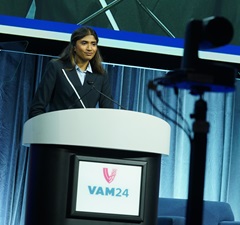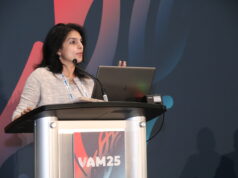
“Our findings ultimately suggest that vascular evaluation within six weeks of wound appearance can significantly supplement wound healing in wound centres,” said Saranya Sundaram, vascular surgery resident (PGY-3) at the Medical University of South Carolina in Charleston, USA, presenting data from an 80-limb retrospective analysis at the 2024 Vascular Annual Meeting (VAM; 19–22 June, Chicago, USA).
Sundaram went on to relay that—based on the study findings—vascular-provider encounters within six weeks of wound appearance may be associated with accelerated time to wound healing; shorter time to wound-healing checkpoints; shorter time to operative intervention; and reduced overall use of wound-clinic resources.
Detailing the backdrop for the present study, the speaker told VAM 2024 that, while some prior data from academic hospital-associated wound care centres have suggested improvements in wound-healing outcomes when wound management is driven by vascular providers, it “remains unclear” whether or not this benefit is derived solely from early vascular provider involvement.
“We studied if simply limiting the time to vascular provider evaluation could benefit wound healing in patients with arterial insufficiency,” Sundaram reported, noting that, in this instance, vascular providers were either board-certified vascular surgeons or advanced practice providers with at least five years of vascular experience. “We also looked at other measures of resource expenditure to determine if additional benefits could be derived in this potential public health target.”
The presenter stated that she and her colleagues examined patients seen at their institution’s wound centre from its initial opening in 2022 through its first year (July 2022–July 2023). In addition, a sensitivity analysis deemed six weeks to be an “appropriate exposure cutoff” after wound appearance. Sundaram and colleagues ultimately identified 45 limbs evaluated within six weeks (early-exposure group) and 35 limbs that were not (late/no-exposure group). Similar socioeconomic, medication use and comorbidity profiles were observed across both groups—and more patients were appropriately managed on aspirin, statins and insulin after establishing care with a wound centre.
“While only 80.6% of late-exposure patients were evaluated by a vascular provider, care was more often supplemented by other surgical subspecialties, such as plastic surgery or orthopedic,” Sundaram said, moving onto the study’s results. “Interestingly, only 51.4% of late-exposure patients had ABI [ankle-brachial index] testing available at initial evaluation.”
She went on to detail that more “classical” arterial-wound distribution was observed among the early-exposure patients, versus a more mixed pattern within the late/no-exposure group, although this difference did not reach statistical significance. Early-exposure wounds, Sundaram continued, grew to be roughly double the maximum size of their later counterparts (27.1cm2 vs. 11.8cm2), despite wound sizes being similar upon initial evaluation (14.3cm2 vs. 10cm2). Baseline wound and ischemia scores also appeared to be significantly higher in the early-exposure group, although infection scores were comparable, as per initial SVS Wound, Ischemia and foot Infection (WIfI) scores. In addition, baseline non-invasive testing outcomes were similar between groups, as was the rate of patients who ultimately underwent operative intervention during their wound course.
“Kaplan-Meier analysis suggested faster wound healing may be seen in the early-exposure group—however, this difference did not attain statistical significance,” the speaker said. “Though, when we accounted for possible confounding factors on Cox regression analysis, we did find that earlier vascular exposure was associated with a nearly 2.5-times faster healing rate. And, on a more granular level, established checkpoints associated with wound closure—such as maximum wound size, a size reduction of greater than 15% in one week, presence of greater than 75% granulation tissue within the wound, and evidence of epithelialization—were all achieved at a much faster pace in the early-exposure group.
“Another interesting finding was that more late-exposure patients had radiographic evidence of osteomyelitis; though, fewer wounds underwent operative debridement in addition to antibiotic therapy. Ultimately, seven of the early-exposure patients and four of the late-exposure patients did require major amputation. However, all early-exposure patients had documented discussion of non-salvageable limbs prior to the decision for amputation.
“In terms of resource expenditure, earlier vascular exposure limited the average number of wound-centre visits and procedures—without transposing the burden to surgical-provider visits; though, these patients were more likely to undergo at least one additional operative intervention than their [late-exposure] counterparts. If intervention was indicated, early-exposure patients underwent these procedures within a much shorter timeframe, among either revascularisation or debridement [procedures].”
Sundaram noted that its single-centre nature and the hospital affiliation of the wound centre in question are among the study’s limitations, and these factors may diminish its generalisability to community models.
“We believe that early specialty referral and evaluation for any patient that has a concern for arterial disease could represent a simple target among wound centres that both improves long-term outcomes and limits resource waste—ultimately, non-salvageable limbs,” the presenter concluded, also positing that early vascular referral from wound centres should therefore be “prioritised” across patients with any history or evidence of arterial insufficiency.













